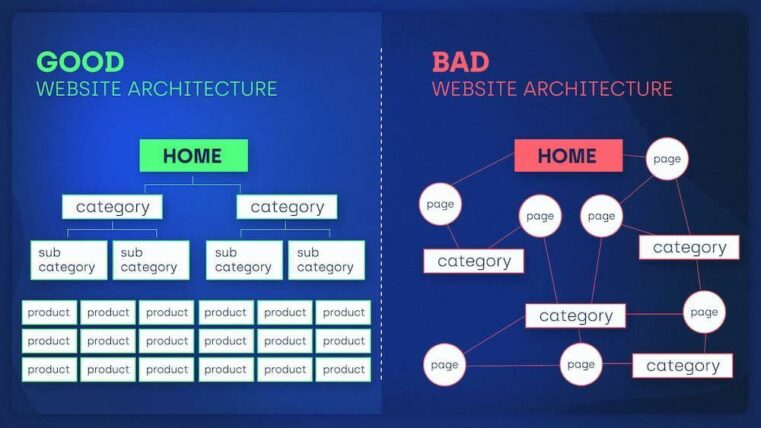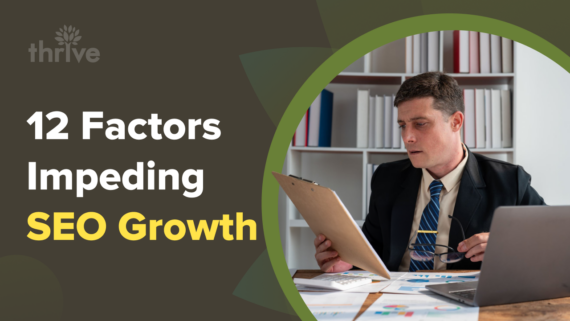According to Ahrefs, 90.63% of content gets no organic traffic from Google and only 0.21% of content gets 1,000 monthly visits.
Why is this happening? What factors could be slowing down your search engine optimization (SEO) efforts and preventing you from achieving higher rankings?
Here are 12 common factors that might be holding back your SEO progress:
• Keywords Aren’t as Competitive as You Think!
• Poor Site Architecture
• Lack of Mobile Optimization
• Technical SEO Issues
• Thin or Duplicate Content
• Local SEO Not Optimized
• Insufficient Backlinks
• Google Manual Actions
• Overlooking Meta Tags
• Insufficient Social Signals
• Poor Online Reputation
• Failure to Track SEO Efforts
1. Keywords Aren’t as Competitive as You Think!
The higher the competition for a particular keyword or phrase, the more time it requires to achieve a higher ranking.
Especially if you’re new to the SEO game, focusing on long-tail keywords with lower competition is essential. These keywords may have a low search volume, but they are more specific and targeted, making it easier for your website to rank higher.
Additionally, targeting less competitive keywords helps establish your website’s authority in its niche, making it more likely to rank for more competitive terms in the future.
The Solution
So, how can you identify low-competition yet still high-traffic keywords for your website? Here are a few tips:
• Conduct thorough keyword research using Google Keyword Planner, SEMrush or Ahrefs.
• Analyze your competition and identify keywords they are not targeting.
• Use long-tail keywords that incorporate specific phrases or questions related to your niche.
• Identify keyword difficulty and prioritize targeting keywords with a lower difficulty score.
• Monitor competitor keyword rankings and target similar or related keywords for your website.
| 💡 Pro Tip: Quality over quantity is key in keyword selection. It’s better to target a few highly relevant, low-competition keywords than try to rank for a high volume of competitive ones, especially if your website is new or has a lower domain authority (the website’s overall credibility in the eyes of search engines). |
|---|
2. Poor Site Architecture
Poor site architecture is another common factor slowing your SEO progress. This refers to the structure and organization of your website, which plays a significant role in search engine crawlability and website indexing.
Well-Designed vs. Poor Site Architecture Example

Here’s how good site architecture can benefit your SEO:
• A logical and organized site structure makes it easier for search engines crawling and website indexing.
• It helps distribute link authority throughout your site, improving all pages’ overall visibility and ranking.
• A well-structured website makes navigating and finding relevant content easier, leading to a better user experience and lower bounce rates.
The Solution
• To improve your site’s architecture and boost your SEO, consider the following:
• Use a clear and logical hierarchy for your website’s pages and content.
• Ensure each page on your site is reachable within three clicks from the homepage.
• Include internal links throughout your website for easy navigation and distribution of link authority.
• Use breadcrumbs to help users understand their location within your site and navigate back to previous pages.
• Optimize your URL structure using descriptive, keyword-rich URLs instead of random numbers or letters.
• Use XML sitemaps to help search engines understand the organization and structure of your website.
| 💡 Pro Tip: Regularly audit and update your site’s architecture as your website grows. This ensures that it remains efficient and user-friendly – both important factors for SEO success. |
|---|
3. Lack of Mobile Optimization
In 2015, Google introduced mobile-friendliness as a ranking factor for its search algorithm. Mobile optimization makes sense since most Americans are glued to their phones for over 3.34 hours daily (Statista, 2022).
Additionally, mobile internet usage has surpassed desktop computer usage, accounting for 60% of online traffic worldwide.
That’s why having mobile friendly websites is crucial for SEO success.
The Solution
Here are some tips to achieve mobile friendly websites:
• Use a responsive design that adjusts to fit different screen sizes and resolutions.
• Optimize images and videos for smaller screens, ensuring they don’t slow down page loading speeds.
• Ensure your website’s fonts are readable on small screens.
• Ensure buttons and links are easy to click without accidentally tapping other elements.
• Test mobile friendly websites using Google’s Mobile-Friendly Test or other similar tools.
| 💡 Pro Tip: Creating a separate mobile version of your website is not recommended. It can cause duplicate content issues and negatively affect SEO rankings. Instead, focus on optimizing your existing site for all devices. |
|---|
4. Technical SEO Issues
Technical SEO issues like broken links, slow page loading speeds or crawlability can significantly impact your SEO progress.
The Solution
Ensure that your website is technically sound and free of errors with this checklist:
• Site speed: Ensure fast loading across all devices.
• Sitemap errors: Check for errors in the sitemap.xml file.
• Robots.txt: Confirm proper indexing permissions in robots.txt.
• 404 errors: Handle 404 errors correctly.
• Redirects: Configure permanent and temporary redirects accurately.
• SSL certificate: Have an SSL certificate and redirect from HTTP to HTTPS.
• Image optimization: Optimize image size, format and metadata.
• Favicon: Include a favicon in various resolutions.
How Often Should I Perform an SEO Audit?
An SEO audit is beneficial at any time, but these indicators suggest your website may need one soon:
• Falling organic traffic and conversions
• High bounce rate
• Declining keyword rankings with no explanation
• Decreasing customer satisfaction (research shows that SEO can improve ranking quality and enhance visitor satisfaction)
| 💡 Pro Tip: You’ll also want to perform an SEO technical audit after building a new website, migrating your site to a new platform or making significant changes to your website. |
|---|
Generally, performing an SEO technical audit quarterly is a good idea to ensure your website is always optimized for search engines.
5. Thin or Duplicate Content
It’s time we chat about another SEO faux pas—thin or duplicate content. This refers to web pages with very little or identical content.
What’s the issue here? Well, search engines like Google are moneyballers for original and quality content. If your website has pages with scanty, non-informative content or has the same content dancing around, search engines may give your website a miss. This also confuses your audience and hurts your credibility.
The Solution
Ensure content quality with these simple tips:
• Make every page count. Ensure each page on your site is loaded with substantial, relevant and engaging content.
• Use canonical tags to tell search engines which version of a page to display if you have similar content across multiple pages.
• Avoid using manufacturer’s product descriptions if you’re an eCommerce site. Instead, create original, high-quality product descriptions that resonate with your audience.
• Observe content quality by regularly auditing your site for thin or duplicate content.
| 💡 Pro Tip: Content is king in the SEO realm. So, keep it original, keep it informative and most importantly, keep it fresh! Remember, the best SEO strategy is to play nice with search engines and provide value to users. |
|---|
6. Local SEO Not Optimized
Let’s not forget: SEO is not just global; it’s local, too, and not giving it the attention it deserves is like ignoring those loyal customers who live around the corner.
Imagine you run a bakery in Boston. You don’t want your website to appear when someone in Los Angeles googles ‘best bakeries near me,’ do you? That’s where the magic of local SEO steps in.
It’s a hyper-focused form of search engine performance optimization that targets specific geographical areas and helps local businesses connect with their target audience.
The Solution
Here are some performance optimization tips for local SEO:
• Use location-specific terms in page titles, meta descriptions and content when conducting keyword optimization.
• Claim and optimize your Google Business Profile (GBP) listing by providing accurate information about your business, including address, phone number and operation hours.
• Encourage customers to leave reviews on your GBP and respond to them promptly.
• Use local directories and citations to list your business information consistently across the web.
• Embed a Google Map of your business location on your website.
• Keep your NAP information consistent across all platforms and directories.
| 💡 Pro Tip: Local SEO is more than just a one-and-done kind of thing. Keep an eye on your local search rankings, perform keyword optimization and make improvements as needed. |
|---|
7. Insufficient Backlinks
Backlinks, the unsung heroes of SEO, deserve your attention and diligence. A robust backlink profile strongly indicates your website’s credibility and domain authority.
But building such a profile is not an easy task; it is an art that requires patience, strategy and, yes, you guessed it right, some quality link building SEO services.
The Solution
Here are a few strategies to boost your backlink profile:
• Guest Posting: Write high-quality, engaging content for other websites in your industry. This builds your brand’s authority and provides opportunities for backlinks.
• Broken Link Building: Find broken links on other websites and suggest your content as a replacement.
• Skyscraper Technique: Identify the best performing content in your niche, create something of higher quality and reach out to the right people.
It’s not about the quantity of backlinks but the quality that truly matters. Target high-domain authority websites for your link building efforts; remember, consistency is key.
| 💡 Pro Tip: Avoid link schemes or shortcuts, which might lead to penalties. Instead, invest in quality link building SEO services for sustainable results. |
|---|
8. Google Manual Actions
Google’s manual actions are every website owner’s worst nightmare. These result from violating Google’s Webmaster guidelines and can significantly slow down your search performance optimization efforts.
The good news is that you can recover from these penalties by fixing the issues that led to them.
The Solution
Here are some tips to help you avoid manual actions:
• Familiarize yourself with Google’s webmaster guidelines.
• Regularly check for crawl errors and fix them immediately.
• Monitor your backlink profile and disavow any spammy or low-quality links.
• Keep an eye on keyword stuffing, hidden text and other black hat SEO tactics that can lead to penalties.
| 💡 Pro Tip: If you do get hit with a manual action, don’t panic. Follow Google’s instructions for fixing the issue and submit a reconsideration request. In most cases, your website will recover once the issue is resolved and the request is approved. |
|---|
9. Overlooking Meta Tags
Meta tags are the first impression of your website on searchers and search engines. They summarize what your page is about, making them crucial for SEO.
Yet, many websites overlook the importance of meta tags, leading to missed opportunities for better visibility in search results.
The Solution
Here’s how you can optimize your meta tags:
• When performing keyword optimization, use relevant keywords in your title tag and keep it under 60 characters.
• Use at least the three levels of H tags (H1, H2, and H3) to structure your content.
• Write an enticing meta description under 155 characters that accurately describes the page’s content and includes a call-to-action.
• Use alt tags for images to provide context and improve accessibility.
| 💡 Pro Tip: Don’t stuff your meta tags with keywords, as this can hurt your rankings. Focus on creating clear, concise, relevant titles and descriptions that entice users to click through to your website. |
|---|
10. Insufficient Social Signals
Social signals are the likes, shares, comments and other interactions on your social media posts. While there is no direct correlation between social signals and search rankings, strong social engagement indirectly impacts your website’s SEO.
The Connection Between Social Engagement and SEO
Firstly, social media can be a powerful tool for promoting your content and driving traffic to your website. When your posts are shared and liked by others, it increases the chances of your content being seen by more people, thus increasing the potential for backlinks and ultimately improving your search rankings.
Secondly, having an active and engaged social media presence can also improve your brand’s reputation, leading to more mentions and backlinks from other reputable websites.
The Solution
Here’s how you can amp up your social media SEO:
• Engage, Engage, Engage: Interact with your audience regularly through comments, likes and shares. Your content’s virality starts with its shareability.
• Quality Over Quantity: Don’t just post for the sake of posting. Ensure content quality by creating relevant, engaging content for your audience. Remember, social engagement is a two-way street.
• Leverage Influencers: Collaborating with influencers with a significant following can exponentially boost your social signals.
• Shareable Content: Create content that your audience would love to share. It could be an infographic, a thought-provoking blog post or a funny meme.
| 💡 Pro Tip: Social media SEO is not just about promoting your content but creating opportunities for your content to be promoted by others. |
|---|
11. Poor Online Reputation
Word spreads fast online, and negative reviews or comments can harm your brand’s reputation. According to BrightLocal’s local consumer survey, 49% of consumers trust online reviews as much as personal recommendations from friends and family.
But how does a poor reputation affect your SEO?
Search engines consider a website’s reputation when determining its credibility and trustworthiness. This impacts your rankings, as search engines want to provide users with the most relevant and trustworthy results.
Negative reviews or comments can discourage potential customers from visiting your website, decreasing traffic and conversions.
The Solution
Here’s how you can manage your online reputation:
• Monitor Your Brand Mentions: Keep an eye on what people say about your brand on social media, review platforms and forums.
• Respond to Negative Comments: Address negative comments or reviews promptly and professionally. This shows that you value customer feedback and are willing to rectify any issues.
• Encourage Positive Reviews: Ask satisfied customers to leave reviews on your website or review platforms. This counteracts negative reviews and improves your overall rating.
| 💡 Pro Tip: Don’t ignore negative comments or reviews, as they can quickly escalate into a PR nightmare. Instead, use them to show your commitment to customer satisfaction. |
|---|
12. Failure To Track SEO Efforts (Underutilizing Analytics Tools)
Ever heard the saying, “You can’t improve what you don’t measure?” It rings true, especially in SEO.
Many marketers surprisingly underutilize analytics tools, leaving them in the dark about how their SEO efforts are faring.
Failing to track your SEO efforts can lead to wasted resources. You might be investing time and money into performance optimization strategies that aren’t working. Worse, you may miss out on opportunities to leverage tactics that yield good results but are overlooked due to the lack of data.
The Solution
Here’s how you can take full advantage of analytics tools:
• Understand Your Metrics: Know your key performance indicators (KPIs). These metrics can include organic traffic, bounce rate, conversion rate, time on site and more.
• Utilize Analytics Tools: Tools like Google Analytics and SEMrush provide valuable insights into your website’s traffic and performance.
• Track Your Progress: Regularly check your metrics to see if your strategies work. Keep track of any changes and trends.
• Analyze and Adjust: Based on your findings, fine-tune your SEO strategies. If something needs to be fixed, feel free to change tactics.
| 💡 Pro Tip: Remember, SEO is a long-term game. Don’t get disheartened if you don’t see immediate results. Track, analyze, adjust—and then do it all over again. |
|---|
Experience Ongoing SEO Growth With Thrive!
Here’s the thing: SEO isn’t a one-time task you do and then forget about. Search engines continuously update their algorithms, new competitors may enter the market and user search habits can change over time.
Thrive, a leading digital marketing agency, can help you stay on top of these changes and ensure your website’s SEO is always up to par.
Max Mechanical Air Conditioning and Heating faced challenges in getting their website found online. Despite working with four different SEO companies, they were not achieving the desired results.
After choosing Thrive, their performance significantly improved. They experienced a remarkable 763% increase in qualified leads, a 15.97% decrease in bounce rate, a 19.70% increase in page views and achieved top 5 keyword rankings.
From technical SEO audits to link-building services, we guarantee long-term growth for your business. Contact Thrive today to experience similar results for your business.








